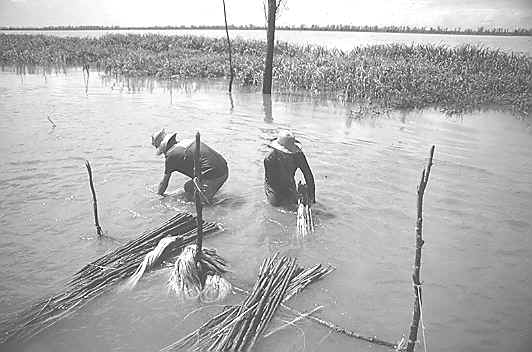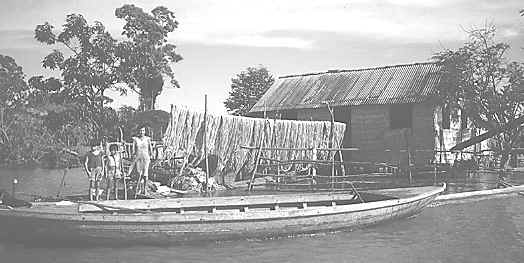 In the twentieth century, jute, Brazil nuts, cattle and wood have been the largest money earning exports from Obidos.
In the twentieth century, jute, Brazil nuts, cattle and wood have been the largest money earning exports from Obidos.  In the twentieth century, jute, Brazil nuts, cattle and wood have been the largest money earning exports from Obidos.
In the twentieth century, jute, Brazil nuts, cattle and wood have been the largest money earning exports from Obidos.
It was at the time when the regional economic forms and social relations were strengthening that jute was introduced by a Japanese colony near Parintins, state of Amazonas. Beginning from the 1930s jute was introduced from South Asia in order to provide for a growing demand for fibrous bags and backing for carpets
During the period of the 1950s to the 1980s there was an intensive cultivation of jute on the floodplain. Most floodplain families were engaged in one way or another in its production, either as part-time harvesters or primary cultivators. According to McGrath and his colleagues (1993) this was a high point for floodplain systems of resource management in the general area of the Lower and Middle Amazon. Jute cultivation made good use of the areas of low-land, and did not require much work except during the harvest, which occurred when the rising waters began submerging its stems.
The production of jute integrated itself into existing pattern of economic activity, which allowed floodplain dwellers to exploit the diverse resources of the environment (rather than make them specialised jute growers). It did not give rise to conflicts in labour, energy and time demands (McGrath et al 1993). This was especially significant given the seasonal variations in the rise and fall of the river and the importance of each activity at different times in the cycle. Most of all, the sale of jute made available quantities of money that allowed people in rural communities to have a degree of purchasing power. The diesel- powered wooden boats, the wooden houses and so on are testament to this increased wealth that accompanied jute production.
In Obidos, jute became an important export by the 1950s. At this time there was one jute factory owned by São Paulo company. The firm had a monopoly in the retail of jute in Obidos area (there were other firms in Santarém, Parintins and Manaus). The jute was bundled and sent to its sister firm in São Paulo to be made up into sacks. In 1974 the company was sold to three Obidense families who ran it as a partnership (sociedade). Each had their own operation, buying jute, providing seeds and financing floodplain cultivation. The juta factory was open for about 3 months very year, from April to August. It would employ 40 people, sometimes 60 for that time.
In Obidos, prices of jute started to fall from the beginning of the 1980s. Within ten years, 1980 to 1990, jute production fell from about 15000 tonnes in the Lower Amazon to 1000 tonnes. The decline in jute prices drove floodplain dwellers to exploit new opportunities.
 The two pictures on this page show some aspects in the process of jute cultivation. The picture above has two men up to their waist in water. Jute is cut under water, that is when it is fully grown after a six month growing period normally around March. The men above have cut the stalks of the jute at their base and laid them out. They then gather a number of stalks and bash them on top of the water. This breaks up the stem and the strands of the fibrous material are left. Men spend the whole day in the water under hot sun or pouring rain (the rainy season will have gotten well under way by this time. They may do so for a few weeks if the crop is large enough or they are working for other people. Many perils are encountered in the water. Not least of which is the sting ray which lies on the river bed and if trodden upon will strike very nastily, often leaving the person laid up for a number of weeks. Arthiritis also is common.
The two pictures on this page show some aspects in the process of jute cultivation. The picture above has two men up to their waist in water. Jute is cut under water, that is when it is fully grown after a six month growing period normally around March. The men above have cut the stalks of the jute at their base and laid them out. They then gather a number of stalks and bash them on top of the water. This breaks up the stem and the strands of the fibrous material are left. Men spend the whole day in the water under hot sun or pouring rain (the rainy season will have gotten well under way by this time. They may do so for a few weeks if the crop is large enough or they are working for other people. Many perils are encountered in the water. Not least of which is the sting ray which lies on the river bed and if trodden upon will strike very nastily, often leaving the person laid up for a number of weeks. Arthiritis also is common.
The second picture is José Maria's and Alcina's house with some of their crop of jute drying outside. It will be bundled when ready and taken to a jute processing factory in a nearby town.